It’s nice to see the seated leg curl exercise getting a look in the research. Of the machine-based leg curl variations for the hamstrings, its a personal favourite.
The more lengthened position comes with range of motion and muscle-building advantages. The seated device is also more secure compared with the lying or upright variations. This can allow for more stability, force output, and less technique variation.
Unfortunately, it’s not as commonly used, or even as available in many gyms. Nonetheless, let’s take a look at a well-done study comparing the leg curl variations.
The Hamstring Muscle Group
Most of the muscles making up the hamstring group are bi-articular. Meaning, they cross and act on two joint systems. In this case, the hamstrings influence both hip and knee actions.
It’s generally accepted the hamstrings have two primary roles. To extend the hip and flex the knee. The biceps femoris short head only crosses the knee so it’s not involved in hip extension.

Hip Extension
For a lot of people, hip extension exercises tend to make up the bulk of their hamstring training. Hip extension-based hamstring exercises such as:
- Romanian deadlift or stiff-legged deadlift
- Good morning
- 45-degree ham raise
These lifts tend to target the whole posterior chain, including the erectors, hamstrings, and glutes, among others.
The deadlift variants in particular are best hit with heavy weight. Loads at around 70-85%1RM and between 6-12 reps work well here.
Keeping in mind these lifts can often cause severe muscle damage and DOMS in the days following. This is because of the heavy eccentric loading as we move into end ranges. As we’ll discuss, high-tension at long muscle lengths is usually more hypertrophic (1,2,3).
This is a big reason why barbell squats don’t contribute much to hamstring muscle growth. In a squat, the hamstring muscles aren’t under a whole lot of tension. The glutes and adductors contribute the most to hip extension and adduction in the squat.
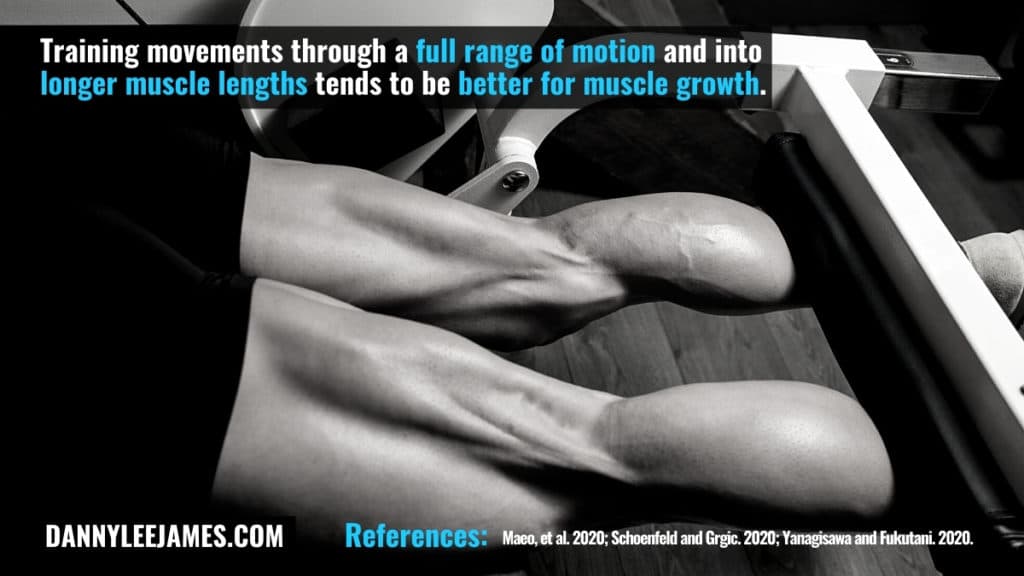
Knee Flexion
In the knee-flexion category, we have fewer options to work with. Generally, the lying, seated or standing machine hamstring curl are the key players.
For curling movements aimed at hamstring muscle growth, moderate to high reps work best with sets of 10-20 reps.
I’ve left other hamstring curl options off the above list on purpose. Exercises like swiss-ball curls and nordic curls are less effective for building muscle. Not hopeless mind you, but there are a tonne of variables you can side-step by using machine curls, instead.
Variables
The inherent instability and loading difficulty of these exercises is a factor. In the case of the nordic curl, many will have a hard time performing enough reps to hit the necessary volume.
There’s also the need to have a partner handy or a stable apparatus to wedge under.
With machine hamstring curl variants, the process is simpler and more effective. You only need to strap in and push your reps out against the padded lever on a guided curve. Incremental load increases are limitless, too.
That’s a whole lot of stability, tension, range of motion, and technique consistency. For these reasons, machine-based hamstring curls could be your go-to for knee-flexion work. Especially when it comes to building muscle.
Leg Curl Fun Facts
It’s not all bad news for the nordic curl.
A study in 2017 found the nordic curl was very effective for increasing hamstring muscle size (4). Another pitted the nordic curl against many of our favourite lifts, including:
- Seated leg curl
- Stiff-legged deadlift
- Single-leg stiff-legged deadlift
- Good morning
- Squat
The nordic outperformed all of them in EMG activity (5). The seated leg curl came in second.
Speaking of activation…
Some research has shown muscle activation is actually higher in knee flexion exercises (3,5,6). Which I found to be very interesting. Many of us tend to focus more on hip extension exercises to maximise hamstring muscle growth.
For more complete hamstring development you want to focus on both of these key movements.
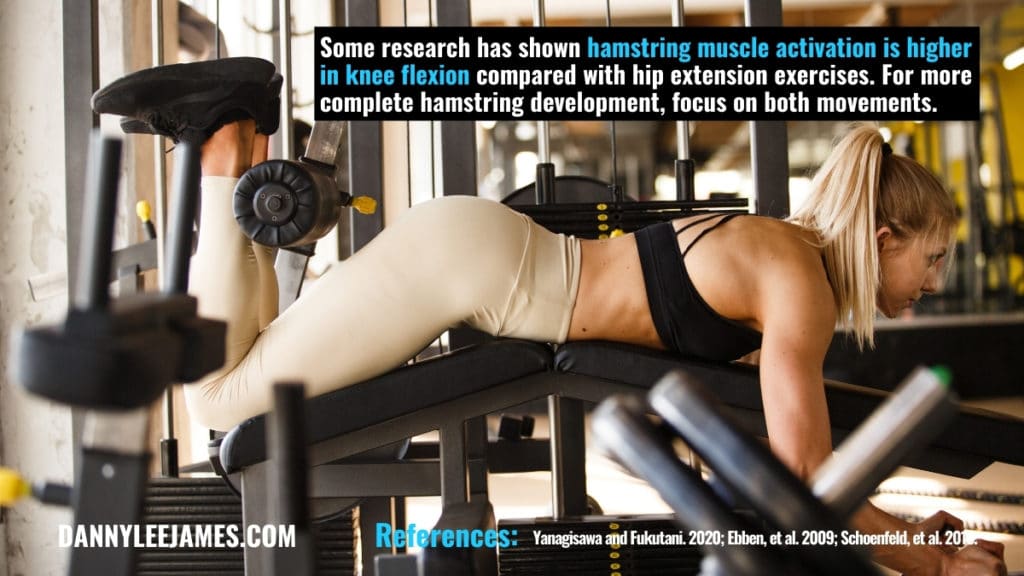
Seated Leg Curl vs Lying Leg Curl
This study looked at the effects on hamstring muscle hypertrophy and susceptibility to muscle damage. The latter having bigger implications for sports performance and injury risk.
The main difference is the seated leg curl places the hamstring in a lengthened position. Owing to greater hip-flexion. The lying leg curl begins at an angle of greater relative hip extension. Thus, a more shortened position.
As per previous research, we would expect the seated leg curl to be better for adding size. Most of the current research supports training into longer lengths for greater hypertrophy.
Training into longer muscle lengths also tends to produce greater muscle damage.
So, would training the seated leg curl offer better protection against muscle damage than the lying leg curl?
Another thing worth mentioning about this great study:
It compares two exercises training through their normal, full range of motion. Studies often compare full and partial ranges of motion of a single exercise.
This gives us a better glimpse of what’s going on.
Related:
- Seated Arnold Press: How To Do That Weird Dumbbell Shoulder Press Exercise Variation
- Arnold Press Muscles Worked and Comparison With the Dumbbell Shoulder Press
- How Low Should You Squat? Rethinking Squat Depth Lore
What Happened?
20 untrained subjects took part in the study. For 12 weeks they did seated leg curls with one leg and lying leg curls with the other.
Training consisted of 5 sets of 10 reps twice per week for both conditions. Loads were at 70% of 1RM and increased by 5% in later sessions if they hit all sets and reps.
Leg dominance was also factored into the design.
Half the subjects did seated leg curls with their stronger leg. The other half performed lying leg curls using their dominant leg.
Afterwards, 19 of those subjects and 12 new, untrained subjects performed another session. This time, they did eccentric hamstring curls for 3 sets of 10 @ 90% 1RM. Again, they performed either the lying or seated leg curl for each leg.
Researchers monitored 1RM strength and muscle damage for up to 72 hours post-exercise. The aim here was to measure each leg curl variation’s effect on resistance to muscle damage.

Leg Curls and Hamstring Muscle Growth
The seated leg curl produced greater hamstring hypertrophy than the lying leg curl. It caused more muscle growth of the semitendinosus, semimembranosus and the biceps femoris long head.
Lying leg curls caused more hypertrophy of the Sartorius. Both exercises caused similar growth of the gracilis and biceps femoris short head.
These findings aren’t altogether surprising. The start position of the seated leg curl places the hamstrings at full length. This lines up with a lot of the emerging evidence on training into long muscle lengths.
Strength gains between the exercises were similar, averaging 31.1% for the seated leg curl and 26.6% in prone.
Leg Curls and Muscle Damage
The other finding on muscle damage was a little more surprising at first. There were similar effects on protection from muscle damage between the exercises.
Strength loss after the eccentric training was greater in subjects who did not take part in the first session. This indicates they incurred more muscle damage as a result.
Both conditions saw a reduced damage response, compared with untrained subjects. But there wasn’t a big difference between the leg curl conditions and the end of the day.
We know training at longer lengths tends to bring about greater muscle damage. So, we expect seated leg curls to cause more of it compared with lying leg curls. And as a result, build up a sturdier resistance against future muscle damage.
This wasn’t the case. Both exercises offered similar protection from muscle damage after eccentric training. Though, it’s possible loading through the eccentric protocol wasn’t damaging enough. Particularly for the subjects who did take part in the previous training.
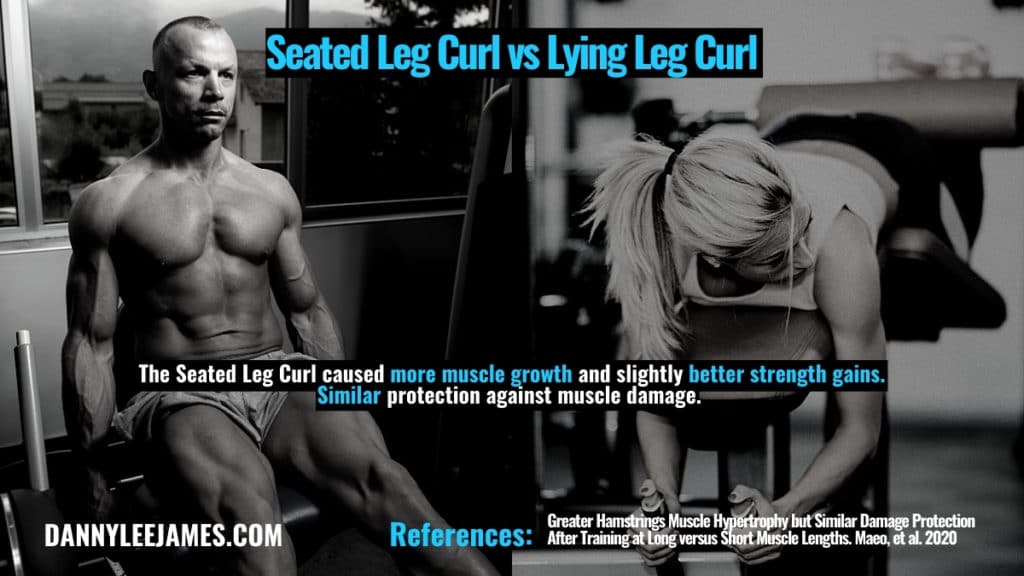
Closing Thoughts
This was a great study providing solid support for training at long muscle lengths to maximise hypertrophy. One of the more thorough studies on the topic.
The seated leg curl is a better option for hamstring muscle growth compared with the lying leg curl. If you had to choose. The lying leg curl is still a great option you can cycle in at times for some variety.
There’s no reason to limit your hamstring workouts to either one. Hypertrophy training is tension dependent, not exercise dependent. As it happens, training at long lengths creates more tension and builds more muscle.
Viva la seated hamstring curls.
References
- Greater hamstrings muscle hypertrophy but similar damage protection after training at long versus short muscle lengths. Maeo, et al. 2020
- Effects of range of motion on muscle development during resistance training interventions: a systematic review. Schoenfeld and Grgic. 2020
- Muscle recruitment pattern of the hamstring muscles in hip extension and knee flexion exercises. Yanagisawa and Fukutani. 2020.
- The effect of nordic hamstring strength training on muscle architecture, stiffness, and strength. Seymore, et al. 2017
- Hamstring activation during lower-body resistance training exercises. Ebben, et al. 2009.
- Regional differences in muscle activation during hamstrings exercise. Schoenfeld, et al. 2015.
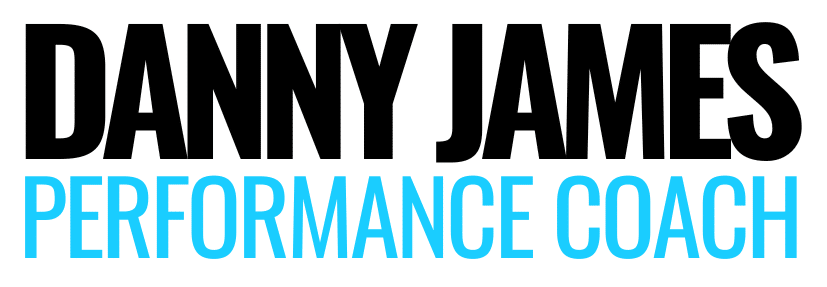
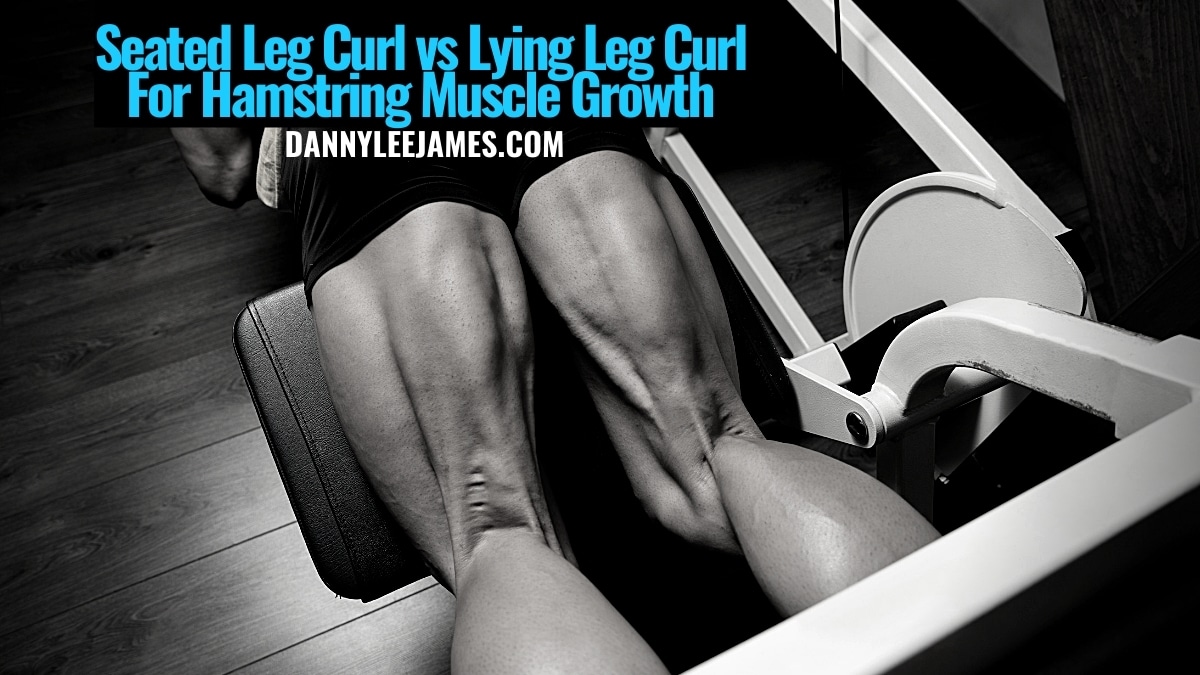






[…] aim is powerlifting, hypertrophy, aesthetics or general […]
[…] Large movements […]
[…] angles place the bi-articular gastrocnemius muscle at a longer length. This tends to lead to greater muscle growth than training at shorter […]
[…] Varying the joint angles of an exercise can be another viable option for potentiating uniform muscle gains. […]
[…] used in the lower body were:Gluteus machine, seated leg curl, abductor machine, leg extension, and adductor […]
[…] Seated Leg Curl vs Lying Leg Curl For Hamstring Muscle Growth – dannyleejames.com […]
[…] does lend some support to the suggestion that light stretching between sets may be beneficial for muscle growth. Provided of course, you’re not stretching too aggressively into discomfort or […]
[…] Starting the movement with arms in front rather than out to the side (frontal plane) involves a fuller range of motion for the anterior deltoid. At the top of the rep, dumbbells allow the arms to come closer, resulting […]
[…] Seated Leg Curl vs Lying Leg Curl For Hamstring Muscle Growth […]